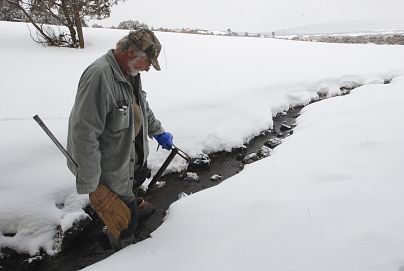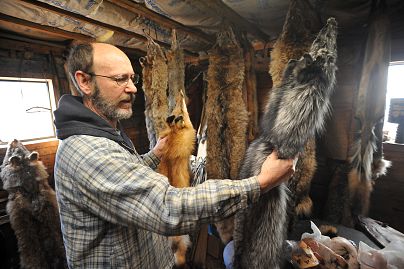"I just think the tide has turned. There are too many people out there on those public lands, and it's like we're walking through a mine field," said a New Mexico man whose dog died in a trap.
An illegally-set steel cable trap likely intended for bobcats caught David Clark's dog Roxy around the neck while they were on a walk on public land near Santa Cruz Lake in New Mexico. Clark said he couldn't figure out how to release Roxy and had to watch his best friend suffocate in his arms.
Nearly 225 miles to the southwest near Roswell, New Mexico, Mike Corn expects to lose at least a third of his sheep herd again this year because of increasingly audacious coyotes that are also beginning to attack his cattle. Traps are one of the key tools to protect his herd and livelihood in an increasingly challenging market, he said.
The two men, who have never met, are in some ways the faces of the two sides of trapping in the United States that fundamentally disagree about the use of land and the impact of trapping on wildlife.
Farmers and trappers say that an increasing number of bills that would further regulate the practice across the country is putting their way of life in jeopardy.
"Every year, there tends to be a handful of bills, but lately it seems like they're coming from every direction," said Skye Good, 29, a trapper who makes hats out of her catches in rural Wisconsin.
"If we could just find some permanent middle ground, that would be best for both sides," she added.
New Mexico is the latest battleground for trapping. A proposed law backed by state Democrats and named for Clark's dog would ban traps, snares and poison on all public lands — approximately 30 percent of the entire state's land mass.
Critics say the trouble is that it will affect areas where farmers and ranchers, like Corn, pay to take their herds through, and removes a tool they need to protect their animals from predators. It would also limit the ability of state-licensed trappers to collect and sell the pelts of animals such as beavers, bobcats and coyotes.
"I hate to think that people believe our only duty, our only goal is to annihilate the coyotes or whatever wildlife they are concerned about," Corn, a fourth-generation farmer, said. "That's not it at all. We have mortgage payments to make and predation is killing us."
The land where Roxy got caught in a trap was already illegal for trappers, and the man who set the trap is facing criminal charges that include more than 30 counts for violating numerous trapping laws. None are related to Roxy's death.
While opponents to the new bill say this shows that the laws on the books are working, Clark said that more regulations are necessary and that the trade should be restricted from all public land.
"I understand where the trappers and ranchers are coming from, but I just think the tide has turned," Clark, a retired ecologist, said from his home in Espanola, New Mexico. "There are too many people out there on those public lands, and it's like we're walking through a mine field."
That sentiment has made its way to numerous statehouses across the country during the past 20 years, which has led to huge limits on trapping as a trade.
California's legislature introduced a bill this year that would terminate all fur-trapping licenses after that statehouse had already prohibited commercial body-gripping traps and totally forbid all bobcat trapping during the previous two decades.
Colorado and Arizona also have bans on traps and snares on public lands. Colorado also prohibits the use of traps, snares and poison on private land.
A handful of states are now considering further legislation that would regulate trapping, including Montana, which is a state known for its few limits on trappers.
KC York, who founded Trap Free Montana about a decade ago, said that she is beginning to find momentum to regulate trapping in her state.
A bill pushed by the former veterinary technician would have forced trappers to check their traps once a day. Though the legislation died in committee, York said it signals a growing trend and support for her advocacy.
"Usually we're on the other end trying to stop some bad bills," she said, referring to legislation that favors trappers. "This is the first time we've gotten a sponsor who wanted to help address trapping, so we were able to be proactive."
York said that she has seen a fair amount of organized pushback from trappers over the growing amount of legislation.
"I think the trappers are panicked," she said. "They're afraid to give an inch because they think they'll lose everything. They feel so threatened."
Joe Luna, the president of the New Mexico Trappers Association, said people do not know the service that trappers provide, and the problem is that people who take part in the trade tend toward privacy and avoid educating and advocating on behalf of the practice.
"There's a lack of knowledge," Luna said. "Many people think it's inhumane and against the law. They think we're bloodthirsty and barbaric, but they don't get the circle of life. If you don't control the predators, things will get out of control."
Luna pointed to the large number of coyote sightings and attacks in California, which no longer maintains trapping laws. He said that trapping laws as they are work.
U.S. Fish and Wildlife Service biologist Thomas Decker said that there are numerous laws already on the books that limit catching certain species, require individuals to check traps, attend classes and more.
Those, however, differ heavily state-to-state and change frequently.
"State agencies are consistently changing rules around those laws and new bills are often taken up by legislatures," Decker said. "Those are rules and laws that are then enforced by game wardens and law enforcement officers in each state."
"They're not theoretical laws," he added. "People are enforcing them."
Most trappers also follow a set of tenets that tack toward responsible trapping and limiting the impact on wildlife, according to Bryant White, the program manager of trapping policy and furbearer research at the Association of Fish and Wildlife Agencies.
His group conducted a study in which they caught almost 20,000 animals over the past 22 years, White said. Through that research, they developed best management practices that call for trappers to consider animal welfare, the efficiency of the trap in capturing the targeted animal, adding features that only target a specific animal — such as different baits and trap locations — the practicality of the trap and its overall safety.
White said that in their study, which followed these best practices, fewer than one percent of the animals caught were pet dogs, and they were able to release those animals without incident.
"Through trapper education and those types of things, we encourage people to set traps where they're not going to capture pets," White said. "Trappers tend to have pets themselves and know how important those are to people."
White also explained that trapping is scientifically necessary to track various wildlife populations when working to reintroduce species that are endangered or extinct, or when working to limit animal populations that are not native — like nutria, an animal that is causing damage to the nation's wetlands.
But the criticism of trapping largely occurs when it falls outside of the parameters that White described, and all sides agree that it is those who trap without consideration for the laws, regulations and best practices who have brought this issue to the foreground.
Despite that acknowledgment, the passionate battle in New Mexico over trapping appears likely to continue.
"We are one state that everyone looks to because we've always beat them back," Luna said, referring to the animal rights groups that are helping to push the bill in New Mexico. "They just want to wear you down and wear you down until they get their way. But we're not done fighting. The session isn't over."













